One of my favorite things to stumble across are bits of architectural ornamentation that are nearly invisible from the street. Case in point: 150 Nassau, near the Brooklyn Bridge.
Looking up from the ground, this is the view. You can tell there’s a bit of detailing at the top, but it’s too difficult to really make anything out in particular, and I imagine the vast majority of people walk right by without giving it a second thought.
But the other day, I happened to be on the neighboring roof when I noticed something really interesting…
These beautiful angel sculptures mounted in each corner:
Twenty-feet in height, the four terra-cotta angels adorning 150 Nassau’s penthouse were created by Spanish-American sculptor Fernando Miranda in 1895/6. The building itself, once among the tallest in the city, was built by the American Tract Society, a religious publisher who set up shop in New York due to it being a center of wickedness.
There’s something endlessly fascinating to me about creating something so detailed that will nevertheless only be appreciated by the rare few who happen to catch a glimpse from a neighboring window. I love how the extending wings seem to transition from beaux arts to an almost art deco look:
All four angels were recently given a full restoration by Boston Valley Terra Cotta, having fallen into significant disrepair over the past 100+ years. Below, an original angel strapped to the building to prevent an accidental fall. You can read all about the restoration process here:

Finally, topping each of the angels is a globe lamp, which were recently replicated from photographs of the originals. Note the lion head, another bit that is literally invisible at street level.
You can actually get a good view of the angels across the street near the southeast corner of City Hall. Definitely worth checking out, right before you get back to your daily wickedness…
-SCOUT

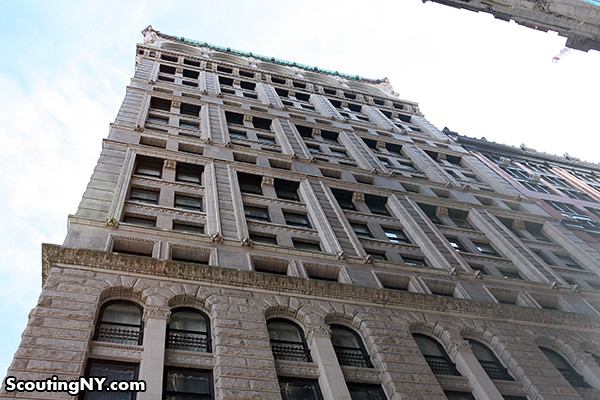
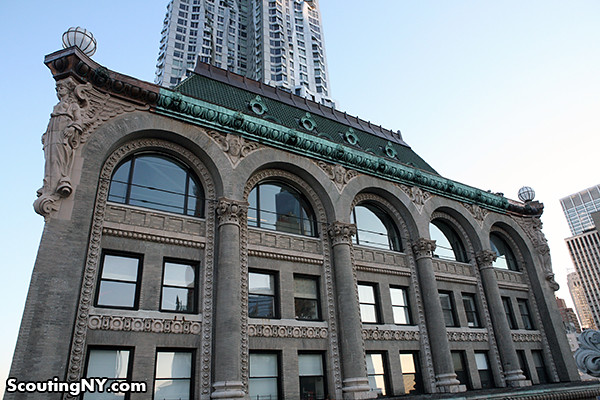
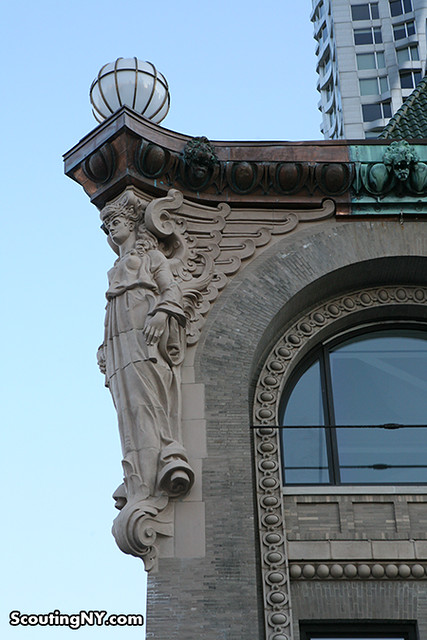
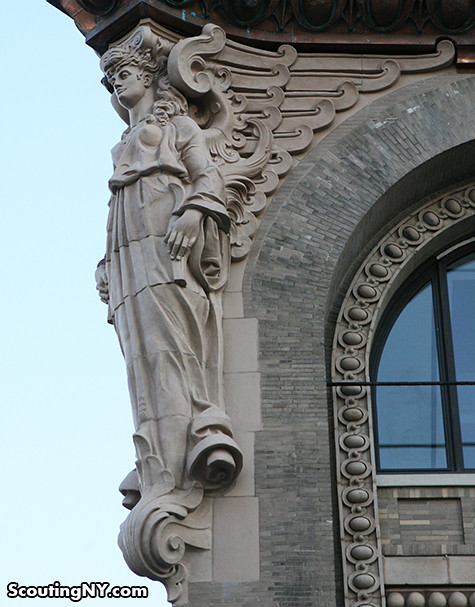
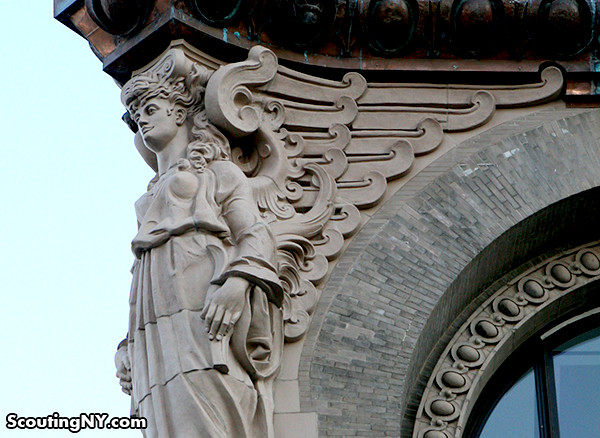

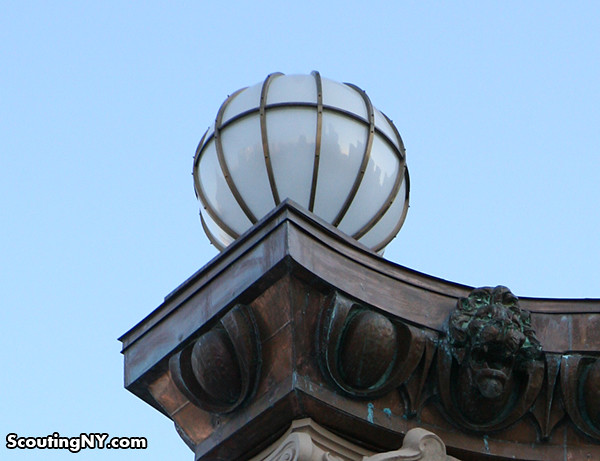

They’re gorgeous!
I couldn’t wrap my head about the scale at first. It’s very hard to tell that the top arched windows are actually 20 feet high, so I thought the measurement of the statues was a typo. Then I saw the photo of the statue lying down next to a person, and it made sense.
Unfortunately, they didn’t actually “restore” the originals. They replaced them with replicas. It looks like they did a fine job, but I’d like to know what became of the originals.
Yes these angels are indeed amazing, and I worked with Old Structures Engineering to replace the four Angels. The contractor West New York Restoration of CT did an amazing job given the location and problems deep inside the structure. Boston Valley Terra Cotta was chosen to reproduce the originals and we removed one complete Angels that was used with other surveys to replicate. Each Angel is comprised of some 58 separate pieces, the largest piece weighing over 400lbs. The illuminated Orbs are a close replica of the original and were made by Rambusch at their Jersey City facility.
You are so right that often some of the most amazing details are often high above the streets and a few of us are lucky to get up close and personal.
I am a resident at 150 Nassau. Yes, the Caryatids (Angels) are lovely. What isn’t lovely is the +$20K in assessments I’m forced to pay to cover the cost – and I have one of the smaller apartments in the building! Overall, the cost is somewhere around $2 MM. Apparently the developer/sponsor made an agreement with Landmarks to fix the statues way back when the building was converted to apartments back in 2002-03. Not long after, he declared bankruptcy. None of this was disclosed when I purchased back in 2008, nor did any/many of my fellow residents know anything about it.
Landmarks didn’t care whether the funding to do the work was coming from the scuzzy developer they made the deal with (whom we can’t go after) or out of the pockets of 150 working families who had no idea what they were on the hook for – they just wanted their statues. When our Local Law 11 – facade re-pointing came due a few years ago, Landmarks blocked our certificate of occupancy until the cosmetic work was done to their liking. This, all for work that the author rightly points out, is nearly impossible to see from the street.
As much as I’d like to be a sponsor of the arts, I’d rather have the $20k in my retirement or my kids 529 account. So if you really enjoy the statues, just send me and my fellow residents a check and we’d be happy to bring you up to the roof for a closer look…
jon: anyone who lives in a landmarked building can probably tell you stories of the increased expenses that come with living in such a building. i have read such stories over the years many a time in the new york times and elsewhere. it’s part of the deal with such a building. at the same time, this is an investment in the resale value of your property. to be blunt by the way, if you can afford to live where you are living, i’m not really crying in my coffee for you anyway. i’m sure that you have a job, but ‘working families’ is kind of a meaningless term these days.
David – please don’t dilute your coffee on my account. What irks me here is the unchecked power of Landmarks. Even if you are legally in the right, if you chose to fight them they will simply get you somewhere else. I actually mourn the loss of Penn Station and I think that the idea of Landmarks is a great thing, but I object to the way they can wield their authority, their lack of accountability, and no reasonable appeals process. The deal they had was directly with the sponsor of the building, it is unconscionable to simply transfer that obligation onto people who had no idea of its existence and could not have known about it even when conducting full due-diligence on the building. Lots of the owners bought back long before FiDi was cool – just because the value of their apartments went up since doesn’t mean they have more cash on hand to satisfy an obligation foisted upon them by a fraud and enforced by a zealot. $2 Million for objects that most people will never see? If it had been at least spent at street level to make Nassau St. more appealing, maybe I could see some sense in it. Or spent refurbishing a school? But this — pure waste…albeit pretty.
On a separate note: Awesome website – despite my unhappy cause for being here I think the photos and locations are very cool. Keep up the good work Nick!
Thanks for a great post, Nick. It’s so true that few people see these works of art. I was privileged to live in the Osborne on W 57th at 7th for a number of years and spent many an hour looking at architectural details all around the building, not to mention using binoculars to look at the surrounding neighborhood (this was the 70s, before there were quite so many high rises). The same was true when I lived on upper West End Ave and from my window could see off over the top of the dome of St. John the Divine. That view is now obscured by another giant apartment building of only slightly better than box architectural design. Take each and every opportunity to look for such wonders, as they will be obscured or destroyed much sooner than you think.
Thank you for your efforts to bring the hidden beauty of New York to those of us here on the ground.
Although the angels are visible to a select few, I am delighted that they are there, that they have been restored, and they have friends in high places protecting them and advertising their lofty presence.
Bravo!
A great short movie about the restoration: http://youtu.be/Kf0RK0uNjVY?t=50s
One of my favorite NY sculptures that CAN be seen from the street are the stylized metal rats and scuppers along the steel lines that support the marquee of the Graybar building on Lexington Avenue at 43rd Street.
I pass by the Graybar Building every day and always make a point of checking out the three metal “rats” trying to scurry up the ship’s lines,
only to be thwarted by the conical rat catchers.
Here are some photos:
http://tinyurl.com/nbwm2sx
As Clark Griswold said, it’s a little nipply out.
Seriously, isn’t that a little bit risque for a 19th century religious publisher?